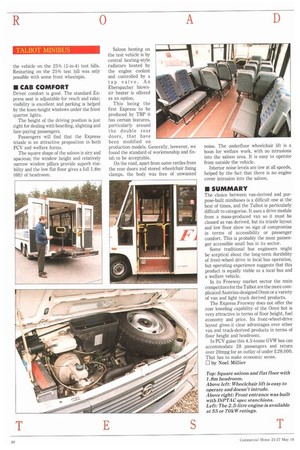TALBOT MINIBUS
Page 38

If you've noticed an error in this article please click here to report it so we can fix it.
the vehicle on the 25% (1-in-4) test hills. Restarting on the 25% test hill was only possible with some front wheelspin.
• CAB COMFORT
Driver comfort is good. The standard Express seat is adjustable for reach and rake; visibility is excellent and parking is helped by the knee-height windows under the front quarter lights.
The height of the driving position is just right for dealing with boarding, alighting and fare-paying passengers.
Passengers will find that the Express triaxle is an attractive proposition in both PCV and welfare forms.
The square shape of the saloon is airy and spacious; the window height and relatively narrow window pillars provide superb visibility and the low flat floor gives a full 1.8m (6ft) of headroom. Saloon heating on the test vehicle is by central heating-style radiators heated by the engine coolant and controlled by a tap valve. An Eberspacher blownair heater is offered as an option.
This being the first Express to be produced by TBP it has certain features, particularly around the double rear doors, that have been modified on production models. Generally, however, we found the standard of workmanship and finish to be acceptable.
On the road, apart from some rattles from the rear doors and stored wheelchair fixing clamps, the body was free of unwanted noise. The underfloor wheelchair lift is a boon for welfare work, with no intrusions into the saloon area. It is easy to operate from outside the vehicle.
Interior noise levels are low at all speeds, helped by the fact that there is no engine cover intrusion into the saloon.
• SUMMARY
The choice between van-derived and purpose-built minibuses is a difficult one at the best of times, and the Talbot is particularly difficult to categorise. It uses a drive module from a mass-produced van so it must be classed as van derived, but its trimde layout and low floor show no sign of compromise in terms of accessibility or passenger comfort. This is probably the most passenger accessible small bus in its sector.
Some traditional bus engineers might be sceptical about the long-term durability of front-wheel drive in local bus operation, but operating experience suggests that this product is equally viable as a local bus and a welfare vehicle.
In its Freeway market sector the main competitors for the Talbot are the more complicated Austrian-designed Omni or a variety of van and light truck derived products.
The Express Freeway does not offer the rear kneeling capability of the Omni but is very attractive in terms of floor height, fuel economy and price. Its front-wheel-drive layout gives it clear advantages over other van and truck-derived products in terms of floor height and headroom.
In PCV guise this 4.5-tonne GVW bus can accommodate 28 passengers and return over 20mpg for an outlay of under £29,000. That has to make economic sense.
El by Noel Mitiler Top: Square saloon and flat floor with 1.8m headroom.
Above left: Wheelchair lift is easy to operate and doesn't intrude.
Above right: Front entrance was built with DiPTAC spec stanchions.
Left: The 2.5-litre engine is available at 55 or 70kW ratings.




























































































